brake sensor HONDA CR-V 2016 RM1, RM3, RM4 / 4.G Owners Manual
[x] Cancel search | Manufacturer: HONDA, Model Year: 2016, Model line: CR-V, Model: HONDA CR-V 2016 RM1, RM3, RM4 / 4.GPages: 532, PDF Size: 22.94 MB
Page 90 of 532
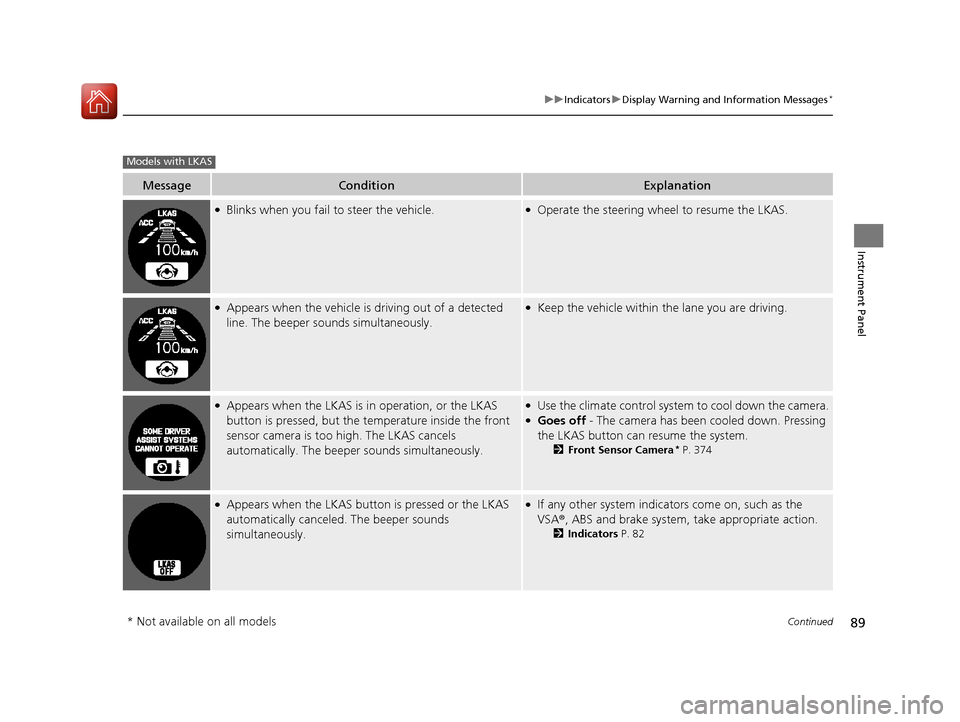
89
uuIndicators uDisplay Warning and Information Messages*
Continued
Instrument Panel
MessageConditionExplanation
ŌŚÅBlinks when you fail to steer the vehicle.ŌŚÅOperate the steering whee l to resume the LKAS.
ŌŚÅAppears when the vehicle is driving out of a detected
line. The beeper sounds simultaneously.ŌŚÅKeep the vehicle within the lane you are driving.
ŌŚÅAppears when the LKAS is in operation, or the LKAS
button is pressed, but the temperature inside the front
sensor camera is too high. The LKAS cancels
automatically. The beeper sounds simultaneously.ŌŚÅUse the climate control system to cool down the camera.ŌŚÅGoes off - The camera has been cooled down. Pressing
the LKAS button can resume the system.
2 Front Sensor Camera* P. 374
ŌŚÅAppears when the LKAS button is pressed or the LKAS
automatically canceled . The beeper sounds
simultaneously.ŌŚÅIf any other system indicato rs come on, such as the
VSA ®, ABS and brake system, take appropriate action.
2 Indicators P. 82
Models with LKAS
* Not available on all models
15 CR-V-31T0A6300.book 89 ŃāÜŃā╝ŃéĖ ’╝Æ’╝É’╝æ’╝ĢÕ╣┤’╝Ƶ£ł’╝ƵŚźŃĆƵ£łµø£µŚźŃĆĆÕŹłÕēŹ’╝æ’╝ɵÖé’╝ō’╝ĢÕłå
Page 348 of 532
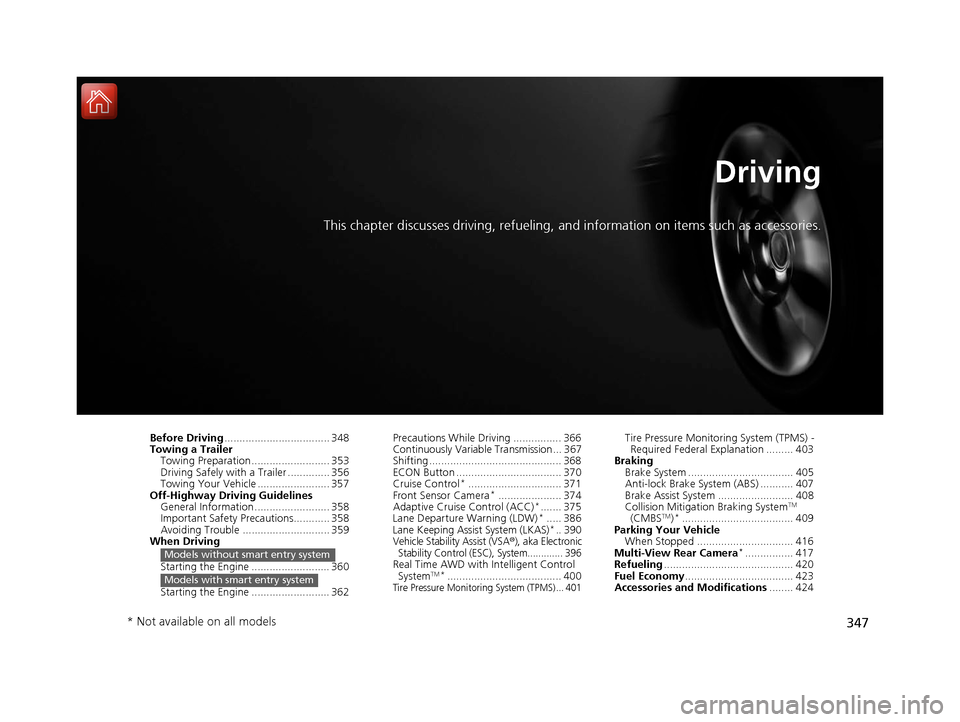
347
Driving
This chapter discusses driving, refueling, and information on items such as accessories.
Before Driving................................... 348
Towing a Trailer
Towing Preparation .......................... 353
Driving Safely with a Trailer .............. 356
Towing Your Vehicle ........................ 357
Off-Highway Driving Guidelines General Information ......................... 358
Important Safety Precautions............ 358
Avoiding Trouble ............................. 359
When Driving
Starting the Engine .......................... 360
Starting the Engine .......................... 362
Models without smart entry system
Models with smart entry system
Precautions While Driving ................ 366
Continuously Variable Transmission... 367
Shifting ............................................ 368
ECON Button ................................... 370
Cruise Control
*............................... 371
Front Sensor Camera*..................... 374
Adaptive Cruise Control (ACC)*....... 375
Lane Departure Warning (LDW)*..... 386
Lane Keeping Assist System (LKAS)*.. 390Vehicle Stability Assist (VSA®), aka Electronic
Stability Control (ESC), System............. 396
Real Time AWD with Intelligent Control
SystemTM*...................................... 400Tire Pressure Monitoring System (TPMS) ... 401
Tire Pressure Monitoring System (TPMS) - Required Federal Explanation ......... 403
Braking Brake System ................................... 405
Anti-lock Brake System (ABS) ........... 407
Brake Assist System ......................... 408
Collision Mitigation Braking System
TM
(CMBSTM)*..................................... 409
Parking Your Vehicle When Stopped ................................ 416
Multi-View Rear Camera
*................ 417
Refueling ........................................... 420
Fuel Economy .................................... 423
Accessories and Modifications ........ 424
* Not available on all models
15 CR-V-31T0A6300.book 347 ŃāÜŃā╝ŃéĖ ’╝Æ’╝É’╝æ’╝ĢÕ╣┤’╝Ƶ£ł’╝ƵŚźŃĆƵ£łµø£µŚźŃĆĆÕŹłÕēŹ’╝æ’╝ɵÖé’╝ō’╝ĢÕłå
Page 376 of 532

375
uuWhen Driving uAdaptive Cruise Control (ACC)*
Continued
Driving
Adaptive Cruise Control (ACC)*
Helps maintain a constant vehicle speed and a set follo wing distance behind a
vehicle detected ahead of yours, without you having to keep your foot on the brake
or the accelerator.1 Adaptive Cruise Control (ACC)*
3WARNING
Improper use of ACC can lead to a crash.
Use ACC only when traveling on open
highways in good weather.
3WARNING
ACC has limited braking capability.
When your vehicle speed drops below 22
mph, ACC will automatically cancel and no
longer will apply your vehicle's brakes.
Always be prepared to apply the brake
pedal when conditions require.
When to use
Ō¢ĀVehicle speed for adaptive cruise control:
Desired speed in a range above roughly 25
mph (40 km/h) ~
Ō¢ĀShift positions for adaptive cruise control:
In ( D or ( S
The radar sensor is inside
the front grille.
The camera is located
behind the rearview
mirror.
* Not available on all models
15 CR-V-31T0A6300.book 375 ŃāÜŃā╝ŃéĖ ’╝Æ’╝É’╝æ’╝ĢÕ╣┤’╝Ƶ£ł’╝ƵŚźŃĆƵ£łµø£µŚźŃĆĆÕŹłÕēŹ’╝æ’╝ɵÖé’╝ō’╝ĢÕłå
Page 381 of 532
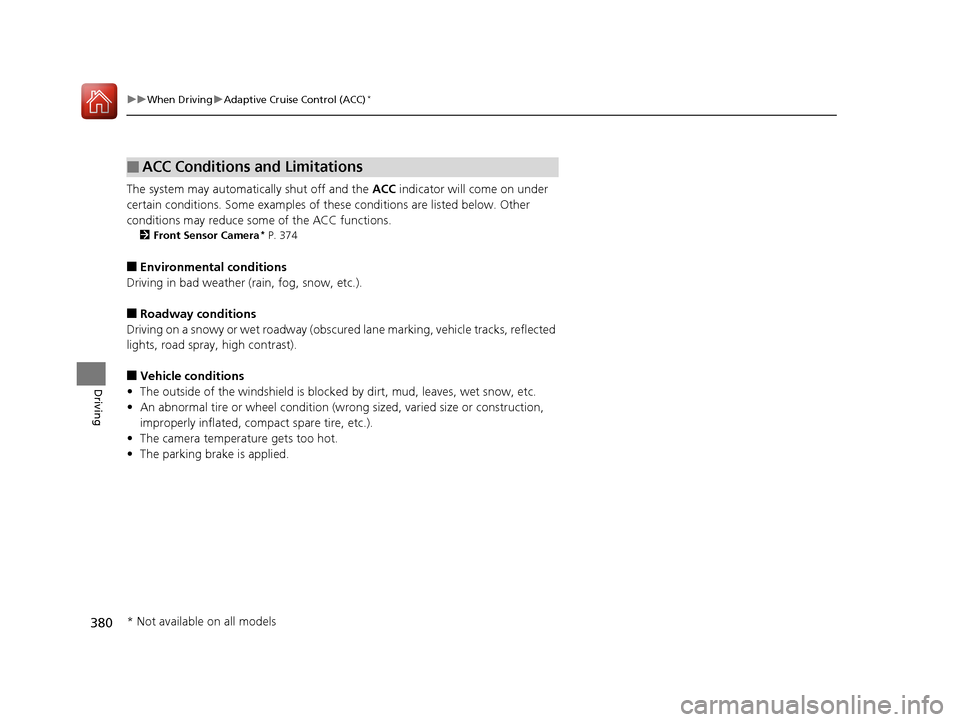
380
uuWhen Driving uAdaptive Cruise Control (ACC)*
Driving
The system may automatically shut off and the ACC indicator will come on under
certain conditions. Some examples of th ese conditions are listed below. Other
conditions may reduce some of the ACC functions.
2 Front Sensor Camera* P. 374
Ō¢ĀEnvironmental conditions
Driving in bad weather (r ain, fog, snow, etc.).
Ō¢ĀRoadway conditions
Driving on a snowy or wet roadway (obscure d lane marking, vehicle tracks, reflected
lights, road spray, high contrast).
Ō¢ĀVehicle conditions
ŌĆó The outside of the windshie ld is blocked by dirt, mud, leaves, wet snow, etc.
ŌĆó An abnormal tire or wheel condition (wrong sized, varied size or construction,
improperly inflated, comp act spare tire, etc.).
ŌĆó The camera temperature gets too hot.
ŌĆó The parking brake is applied.
Ō¢ĀACC Conditions and Limitations
* Not available on all models
15 CR-V-31T0A6300.book 380 ŃāÜŃā╝ŃéĖ ’╝Æ’╝É’╝æ’╝ĢÕ╣┤’╝Ƶ£ł’╝ƵŚźŃĆƵ£łµø£µŚźŃĆĆÕŹłÕēŹ’╝æ’╝ɵÖé’╝ō’╝ĢÕłå
Page 382 of 532
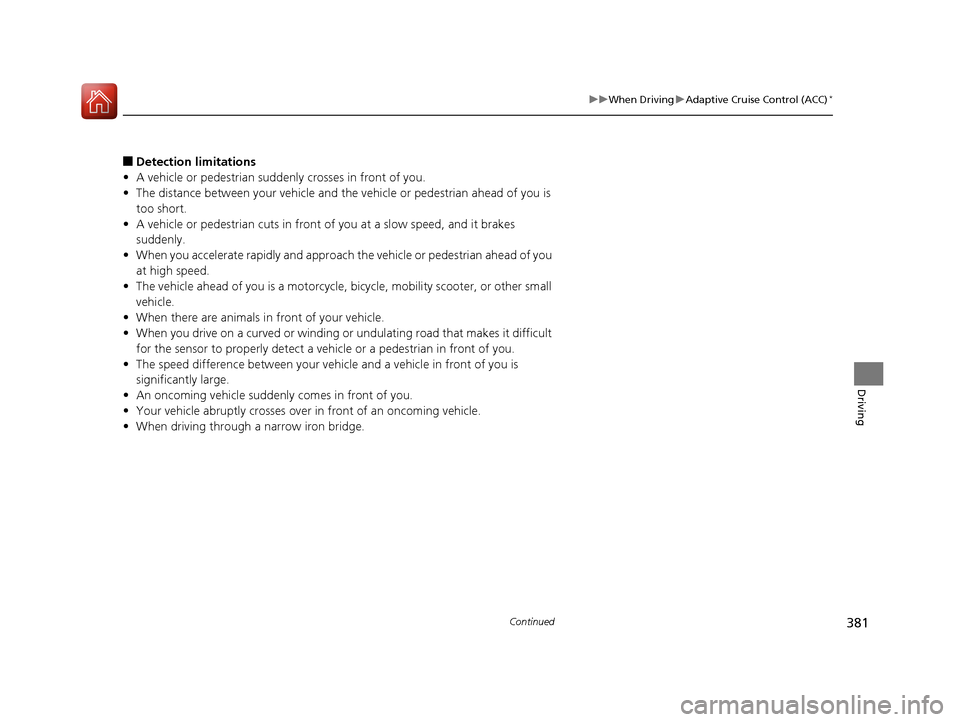
381
uuWhen Driving uAdaptive Cruise Control (ACC)*
Continued
Driving
Ō¢ĀDetection limitations
ŌĆó A vehicle or pedestrian suddenly crosses in front of you.
ŌĆó The distance between your vehicle and the vehicle or pedestrian ahead of you is
too short.
ŌĆó A vehicle or pedestrian cuts in front of you at a slow speed, and it brakes
suddenly.
ŌĆó When you accelerate rapidly and approach the vehicle or pedestrian ahead of you
at high speed.
ŌĆó The vehicle ahead of you is a motorcycle, bicycle, mobility scooter, or other small
vehicle.
ŌĆó When there are animals in front of your vehicle.
ŌĆó When you drive on a curved or winding or undulating road that makes it difficult
for the sensor to properly detect a vehicle or a pedestrian in front of you.
ŌĆó The speed difference between your vehi cle and a vehicle in front of you is
significantly large.
ŌĆó An oncoming vehicle suddenly comes in front of you.
ŌĆó Your vehicle abruptly crosses over in front of an oncoming vehicle.
ŌĆó When driving through a narrow iron bridge.
15 CR-V-31T0A6300.book 381 ŃāÜŃā╝ŃéĖ ’╝Æ’╝É’╝æ’╝ĢÕ╣┤’╝Ƶ£ł’╝ƵŚźŃĆƵ£łµø£µŚźŃĆĆÕŹłÕēŹ’╝æ’╝ɵÖé’╝ō’╝ĢÕłå
Page 385 of 532
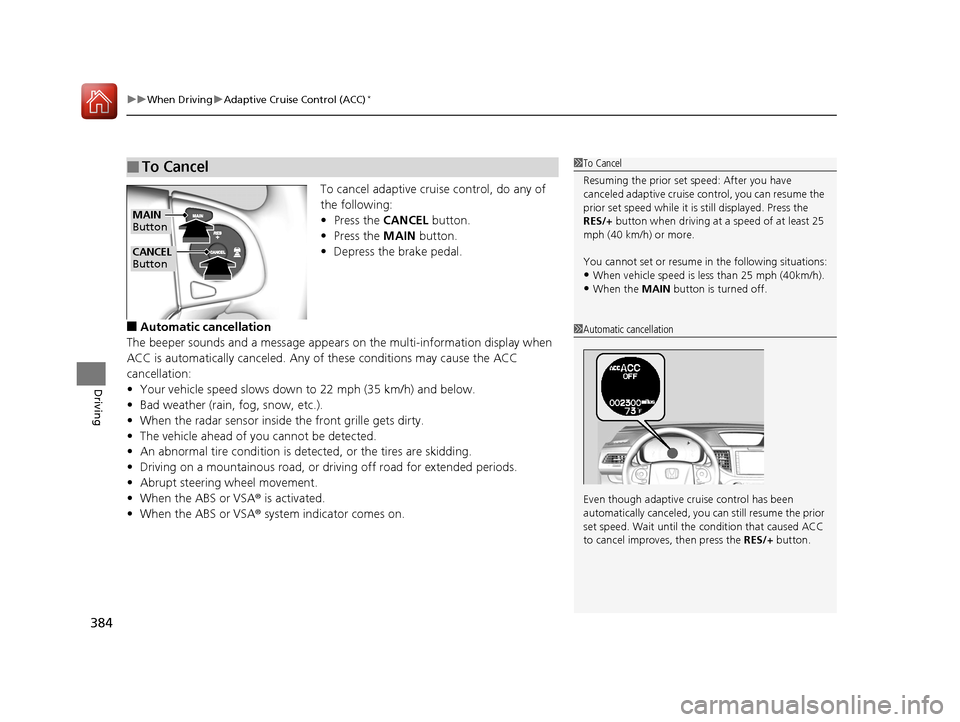
uuWhen Driving uAdaptive Cruise Control (ACC)*
384
Driving
To cancel adaptive cruise control, do any of
the following:
ŌĆó Press the CANCEL button.
ŌĆó Press the MAIN button.
ŌĆó Depress the brake pedal.
Ō¢ĀAutomatic cancellation
The beeper sounds and a message appears on the multi-information display when
ACC is automatically canceled. Any of these conditions may cause the ACC
cancellation:
ŌĆó Your vehicle speed slows down to 22 mph (35 km/h) and below.
ŌĆó Bad weather (rain, fog, snow, etc.).
ŌĆó When the radar sensor inside the front grille gets dirty.
ŌĆó The vehicle ahead of you cannot be detected.
ŌĆó An abnormal tire condition is detected, or the tires are skidding.
ŌĆó Driving on a mountainous road, or driving off road for extended periods.
ŌĆó Abrupt steering wheel movement.
ŌĆó When the ABS or VSA ┬« is activated.
ŌĆó When the ABS or VSA ┬« system indicator comes on.
Ō¢ĀTo Cancel1To Cancel
Resuming the prior set speed: After you have
canceled adaptive cruise c ontrol, you can resume the
prior set speed while it is still displayed. Press the
RES/+ button when driving at a speed of at least 25
mph (40 km/h) or more.
You cannot set or resume in the following situations:
ŌĆóWhen vehicle speed is less than 25 mph (40km/h).ŌĆóWhen the MAIN button is turned off.
CANCEL
Button
MAIN
Button
1 Automatic cancellation
Even though adaptive crui se control has been
automatically canceled, you can still resume the prior
set speed. Wait until the condition that caused ACC
to cancel improves, then press the RES/+ button.
15 CR-V-31T0A6300.book 384 ŃāÜŃā╝ŃéĖ ’╝Æ’╝É’╝æ’╝ĢÕ╣┤’╝Ƶ£ł’╝ƵŚźŃĆƵ£łµø£µŚźŃĆĆÕŹłÕēŹ’╝æ’╝ɵÖé’╝ō’╝ĢÕłå
Page 387 of 532
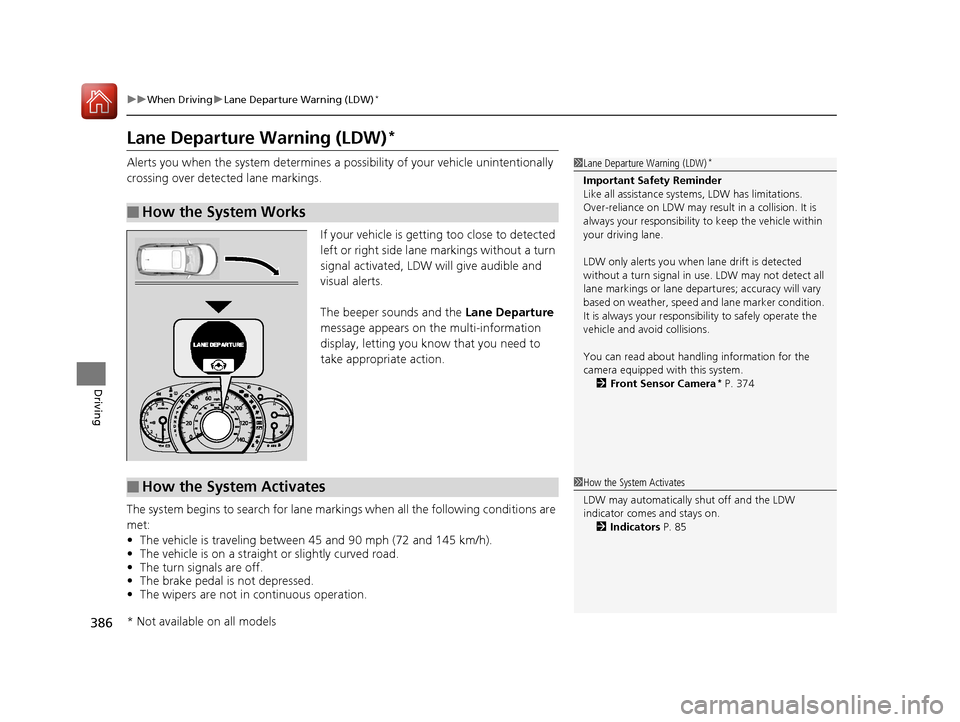
386
uuWhen Driving uLane Departure Warning (LDW)*
Driving
Lane Departure Warning (LDW)*
Alerts you when the system determines a po ssibility of your vehicle unintentionally
crossing over detected lane markings.
If your vehicle is getting too close to detected
left or right side lane markings without a turn
signal activated, LDW will give audible and
visual alerts.
The beeper sounds and the Lane Departure
message appears on the multi-information
display, letting you know that you need to
take appropriate action.
The system begins to search for lane mark ings when all the following conditions are
met:
ŌĆó The vehicle is traveling between 45 and 90 mph (72 and 145 km/h).
ŌĆó The vehicle is on a straight or slightly curved road.
ŌĆó The turn signals are off.
ŌĆó The brake pedal is not depressed.
ŌĆó The wipers are not in continuous operation.
Ō¢ĀHow the System Works
1Lane Departure Warning (LDW)*
Important Safety Reminder
Like all assistance systems, LDW has limitations.
Over-reliance on LDW may result in a collision. It is
always your respons ibility to keep the vehicle within
your driving lane.
LDW only alerts you when lane drift is detected
without a turn signal in us e. LDW may not detect all
lane markings or lane departures; a ccuracy will vary
based on weather, speed and lane marker condition.
It is always your responsibility to safely operate the
vehicle and avoid collisions.
You can read about handling information for the
camera equipped with this system. 2 Front Sensor Camera
* P. 374
Ō¢ĀHow the System Activates1How the System Activates
LDW may automatically shut off and the LDW
indicator comes and stays on.
2 Indicators P. 85
* Not available on all models
15 CR-V-31T0A6300.book 386 ŃāÜŃā╝ŃéĖ ’╝Æ’╝É’╝æ’╝ĢÕ╣┤’╝Ƶ£ł’╝ƵŚźŃĆƵ£łµø£µŚźŃĆĆÕŹłÕēŹ’╝æ’╝ɵÖé’╝ō’╝ĢÕłå
Page 392 of 532

Continued391
uuWhen Driving uLane Keeping Assist System (LKAS)*
Driving
The system can be used when th e following conditions are met.
ŌĆó The lane in which you are driving has detectable lane markers on both sides, and
your vehicle is in the center of the lane.
ŌĆó The vehicle speed is between about 45 and 90 mph (72 and 145 km/h).
ŌĆó You are driving on a straight or slightly curved road.
ŌĆó The turn signals are off.
ŌĆó The brake pedal is not depressed.
ŌĆó The wipers are not in continuous operation.
Ō¢ĀHow to activate the system
1.Press the MAIN button.
u The LKAS is on in the multi-information
display.
The system is ready to use.
2. Press the LKAS button.
u Lane outlines appear on the multi-
information display.
The system is activated.
Ō¢ĀWhen the System can be Used1Lane Keeping Assist System (LKAS)*
You can read about handling information for the
camera equipped with this system.
2 Front Sensor Camera
* P. 374
If the vehicle drifts toward ei ther left or right lane line
due to the system applying torque, turn off the LKAS
and have your vehicle checked by a dealer.
MAIN Button
LKAS Button
* Not available on all models
15 CR-V-31T0A6300.book 391 ŃāÜŃā╝ŃéĖ ’╝Æ’╝É’╝æ’╝ĢÕ╣┤’╝Ƶ£ł’╝ƵŚźŃĆƵ£łµø£µŚźŃĆĆÕŹłÕēŹ’╝æ’╝ɵÖé’╝ō’╝ĢÕłå
Page 410 of 532

409
uuBraking uCollision Mitigation Braking SystemTM (CMBSTM)*
Continued
Driving
Collision Mitigation Braking SystemTM (CMBSTM)*
Can assist you when there is a possibility of your vehicle colliding with a vehicle or a
pedestrian detected in front of yours. The CMBSTM is designed to alert you when a
potential collision is determined, as well as to reduce your vehicle speed when a
collision is deemed unavoidable to help minimize collision severity.
Ō¢ĀHow the system works
1 Collision Mitigation Braking SystemTM (CMBSTM)*
Important Safety Reminder
The CMBSTM is designed to reduce the severity of an
unavoidable collision. It does not prevent collision nor
stop the vehicle automatically. It is still your
responsibility to operate the brake pedal and steering
wheel appropriately acco rding to the driving
conditions.
The CMBS
TM may not activate or may not detect a
vehicle in front of y our vehicle under certain
conditions:
2 CMBS
TM Conditions and Limitations P. 414
You can read about handling information for the
camera equipped with this system. 2 Front Sensor Camera
* P. 374
The system starts monitoring the roadway ah ead when your vehicle speed is about
3 mph (5 km/h) and there is a vehicle in front of you. The radar sensor is
in the front grille.
The CMBS
TM activates when:ŌŚÅThe speed difference between your vehicle and a vehicle or pedestrian
detected in front of you becomes about 3 mph (5 km/h) and over with a chance
of a collision.
ŌŚÅYour vehicle speed is about 62 mph (100 km/h) or less and there is a chance of a
collision with an oncoming detected vehicle or a pedestrian in front of you. The camera is
located behind the
rearview mirror.
When to use
* Not available on all models
15 CR-V-31T0A6300.book 409 ŃāÜŃā╝ŃéĖ ’╝Æ’╝É’╝æ’╝ĢÕ╣┤’╝Ƶ£ł’╝ƵŚźŃĆƵ£łµø£µŚźŃĆĆÕŹłÕēŹ’╝æ’╝ɵÖé’╝ō’╝ĢÕłå
Page 416 of 532
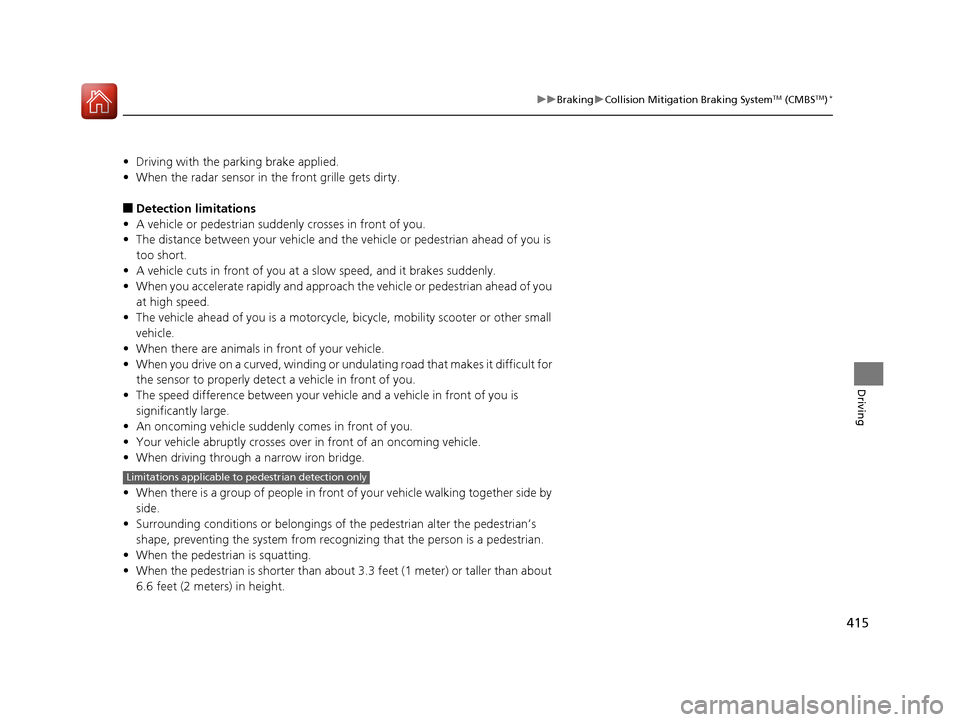
415
uuBraking uCollision Mitigation Braking SystemTM (CMBSTM)*
Driving
ŌĆó Driving with the parking brake applied.
ŌĆó When the radar sensor in the front grille gets dirty.
Ō¢ĀDetection limitations
ŌĆó A vehicle or pedestrian suddenly crosses in front of you.
ŌĆó The distance between your vehicle and the vehicle or pedestrian ahead of you is
too short.
ŌĆó A vehicle cuts in front of you at a slow speed, and it brakes suddenly.
ŌĆó When you accelerate rapidly and approach the vehicle or pedestrian ahead of you
at high speed.
ŌĆó The vehicle ahead of you is a motorcycle, bicycle, mobility scooter or other small
vehicle.
ŌĆó When there are animals in front of your vehicle.
ŌĆó When you drive on a curved, winding or und ulating road that makes it difficult for
the sensor to properly detect a vehicle in front of you.
ŌĆó The speed difference between your vehi cle and a vehicle in front of you is
significantly large.
ŌĆó An oncoming vehicle suddenly comes in front of you.
ŌĆó Your vehicle abruptly crosses over in front of an oncoming vehicle.
ŌĆó When driving through a narrow iron bridge.
ŌĆó When there is a group of people in front of your vehicle walking together side by
side.
ŌĆó Surrounding conditions or belongings of the pedestrian alter the pedestrianŌĆÖs
shape, preventing the system from recogn izing that the person is a pedestrian.
ŌĆó When the pedestrian is squatting.
ŌĆó When the pedestrian is shorte r than about 3.3 feet (1 meter) or taller than about
6.6 feet (2 meters) in height.
Limitations applicable to pedestrian detection only
15 CR-V-31T0A6300.book 415 ŃāÜŃā╝ŃéĖ ’╝Æ’╝É’╝æ’╝ĢÕ╣┤’╝Ƶ£ł’╝ƵŚźŃĆƵ£łµø£µŚźŃĆĆÕŹłÕēŹ’╝æ’╝ɵÖé’╝ō’╝ĢÕłå